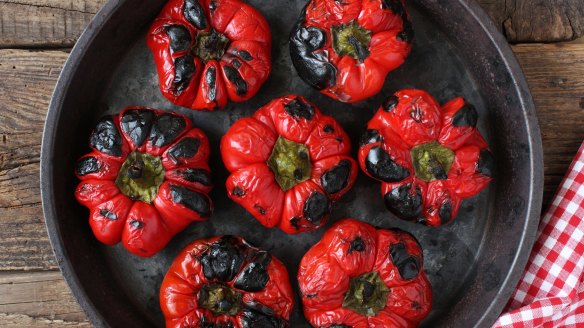The easy way to peel blackened capsicum

- Blackened capsicum salsa recipe
- Smoked salmon with homemade tartare sauce
- Snapper schnitzel recipe with charred lettuce and easy dill tartare sauce
Aside from rubbing the blistered, blackened skin off grilled capsicums, is there an easier way to peel them? D Evans
You are of course talking about cooking red capsicums over a flame or in a scorchingly hot oven, during which time the skin blackens and blisters. If you don't cook the capsicum enough, the skin will not lift off the flesh. Cook it too much and the flesh will fall apart, also making removing the skin difficult. Riper capsicums are easier to peel. I blacken my capsicums the day before I need them and let then sit in their own juices in a container in the fridge. This makes them much easier to peel. Take the juices, season them with a little salt, add some good vinegar and olive oil and you have your dressing. I have also cooked the capsicum and had to leave town unexpectedly and put the capsicum in the freezer. On my return, I've defrosted it and found it incredibly easy to peel.
Is it steak tartar or steak tartare? I thought tartare was a sauce. B. Ho
I have noticed different restaurants interchange the spellings and I too find it a little confusing especially when a menu lists fish with tartar sauce – I think I am going to have a piece of john dory with an incredibly sour condiment made with Cream of Tartar. According to the late Alan Davidson, diplomat and author of the Oxford Companion to Food, the word tartare comes to us from the French and refers to dishes that are attributed to the Tartars, a Turkish-speaking group of people who originated in a region incorporated into the modern Russian Federation. Tartare sauce is made with mayonnaise to which capers, gherkins and herbs are added. Steak tartare is chopped steak, seasoned and served with an egg yolk, mustard, chopped cornichons and other accompaniments. The dropping of the "e" at the end of tartare is common in US spelling (gelatin/gelatine is another example), with the American dictionary Miriam-Webster listing tartar. However, the New York Times prefers "tartare".
Letters
Your letters make this column. You're always asking interesting questions. Please keep them coming. This one, however, drew a tear to our collective eyes at The Brain Food Institute. R. Comino wrote, "This past Christmas you mentioned in an answer to an inquiry regarding plums in Christmas pudding that the best pudding you'd ever make was replacing half the fruit with prunes. So this Christmas I did the same using half prunes, half raisins and it was the best pudding I've ever made! I've made a few in my time given I'm over 80. This recipe is my mother's mother's, so it's an antique recipe, and different in that it only used raisins anyway. Always good but even better using prunes. Thanks." No, Thank you, R. Comino.
Send your vexing culinary conundrums to brainfood@richardcornish.com.au or tweet to @realbrainfood.
Appears in these collections
- More:
- Food
- Brain food
